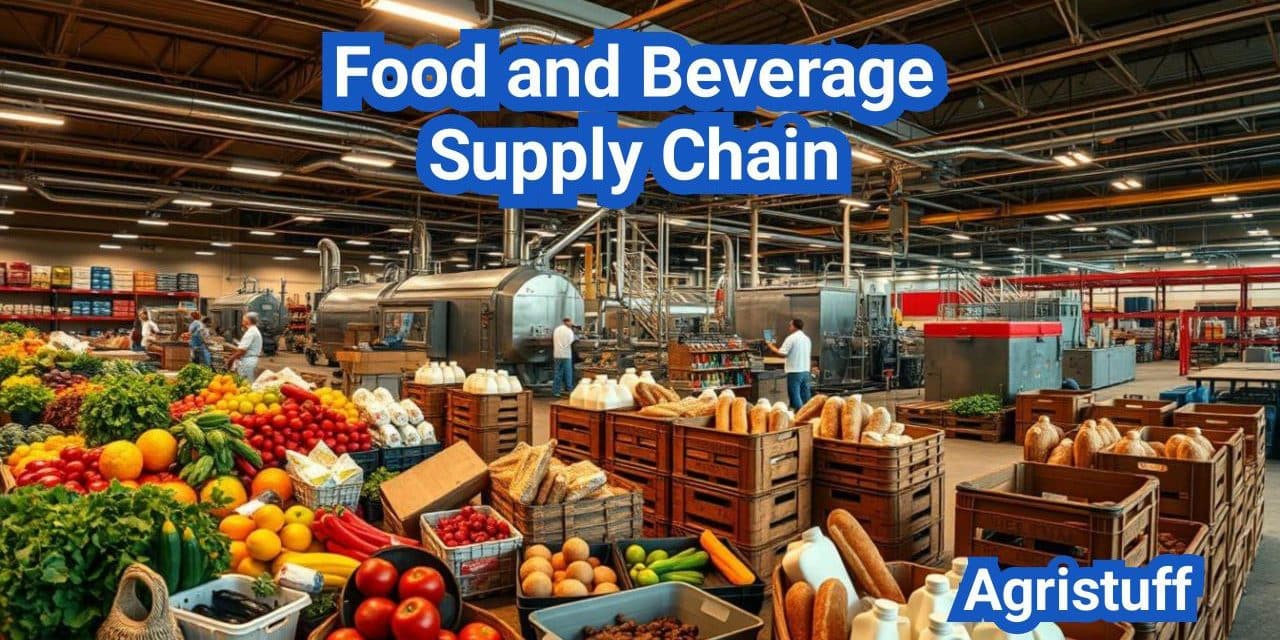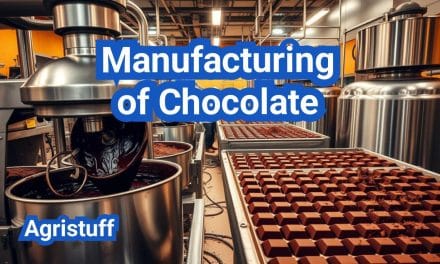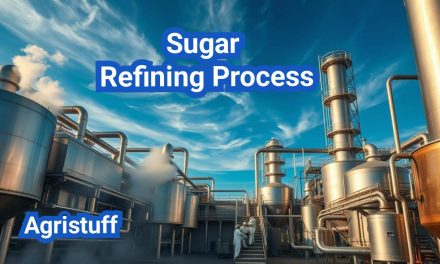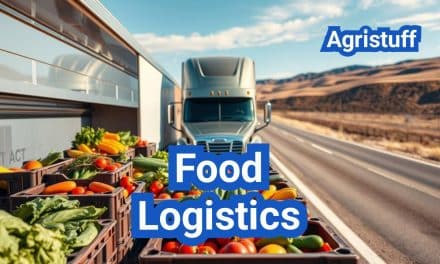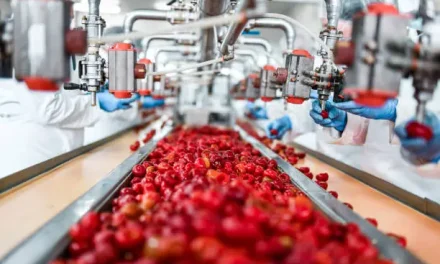The food and beverage supply chain is a complex process that involves sourcing raw materials, processing, and distributing products to customers across the United States.
Efficient supply chain management is crucial in this industry, as it ensures the timely delivery of fresh products while maintaining quality and safety standards.
The stages of the food and beverage supply chain include sourcing, production, and distribution, each presenting unique challenges that require effective management to maintain a competitive edge.
Key Takeaways
- Efficient supply chain management is crucial in the food and beverage industry.
- The supply chain involves sourcing, production, and distribution stages.
- Maintaining quality and safety standards is essential.
- Effective management is required to overcome industry challenges.
- The food and beverage supply chain is complex and multifaceted.
The Fundamentals of Food and Beverage Supply Chain
The food and beverage supply chain encompasses a broad range of activities, including sourcing, production, and distribution. It is a complex system that involves multiple stakeholders, from farmers and processors to distributors and retailers, all working together to ensure that products reach consumers efficiently.
Definition and Scope of Supply Chain Operations
The food and beverage supply chain refers to the entire process of producing and delivering food and beverages, from raw material sourcing to end-consumer delivery. It involves various operations, including agricultural production, processing, packaging, storage, and transportation. Effective supply chain management is crucial for ensuring the quality, safety, and availability of food products.
Economic Impact in the United States
The food and beverage supply chain has a significant economic impact in the United States. It contributes substantially to the country’s GDP and provides employment to millions of people across different sectors. The economic influence of the supply chain is felt not only in rural areas where agricultural production is prominent but also in urban centers where processing, distribution, and retail activities are concentrated.
Comparison with Other Industry Supply Chains
Compared to other industries, the food and beverage supply chain is unique due to its complexity and the perishable nature of its products. Unlike the supply chains for durable goods, the food and beverage supply chain requires specialized infrastructure, such as cold storage facilities and refrigerated transportation, to maintain product quality and safety. Additionally, the industry is subject to stringent regulations and standards to ensure food safety, which adds another layer of complexity to supply chain operations.
Key Stages of the Food and Beverage Supply Chain

The journey of food and beverages from farm to table involves several critical stages. Understanding these stages is essential for managing the supply chain effectively and ensuring that products reach consumers safely and efficiently.
Agricultural Production and Raw Material Sourcing
Agricultural production is the foundation of the food and beverage supply chain. It involves the cultivation of crops, raising of livestock, and production of raw materials that will be used in the manufacturing process. The quality and quantity of these raw materials significantly impact the final product.
Key aspects of agricultural production include:
- Crop selection and rotation
- Livestock management
- Use of technology for precision farming
- Sustainable farming practices
As noted by agricultural experts, “Sustainable agricultural practices are crucial for maintaining soil health, conserving water, and reducing the environmental impact of farming.”
“The way we farm today will determine the future of our planet. Sustainable agriculture is not just a moral imperative, it’s an economic necessity.” –
Unknown
Processing and Manufacturing Operations
Once raw materials are sourced, they undergo processing and manufacturing to transform them into consumable products. This stage involves various operations such as cleaning, sorting, packaging, and labeling.
The processing and manufacturing stage is critical for ensuring product safety and quality. It requires adherence to strict regulations and guidelines to prevent contamination and ensure compliance with food safety standards.
| Operation | Description | Importance |
|---|---|---|
| Cleaning | Removing dirt and contaminants from raw materials | High |
| Sorting | Classifying products based on quality and size | Medium |
| Packaging | Protecting products during transportation and storage | High |
Distribution Networks and Retail Channels
The final stage of the food and beverage supply chain involves distribution and retail. Products are transported through various distribution networks to reach retail channels, where they are made available to consumers.
Effective distribution and retail strategies are crucial for ensuring that products are delivered to the right place, at the right time, and in the right condition. This involves managing logistics, inventory, and supply chain visibility.
Key considerations for distribution and retail include:
- Transportation mode selection
- Inventory management
- Supply chain visibility
- Retail channel optimization
Understanding Food Supply Chain Models
Understanding the various models of food supply chains is crucial for businesses operating in the food industry. Different supply chain models offer varying levels of flexibility, cost control, and responsiveness, which can significantly impact the efficiency and resilience of the supply chain.
Conventional Supply Chain Structure
The conventional supply chain structure is a traditional model that involves a linear progression from farmers to processors, then to distributors, and finally to retailers. This model is often characterized by a lack of direct communication between different stages, which can lead to inefficiencies and increased costs.
Advantages: The conventional model is well-established and widely understood, making it easier to manage for companies with existing infrastructure.
Disadvantages: It can be less responsive to changes in demand and may result in higher costs due to inefficiencies.
Integrated Supply Chain Systems
Integrated supply chain systems involve a more coordinated approach, where different stages of the supply chain are interconnected through technology and data sharing. This model enhances visibility, reduces costs, and improves responsiveness to consumer demands.
- Improved inventory management
- Enhanced traceability
- Better demand forecasting
Local and Regional Supply Chains
Local and regional supply chains focus on producing and distributing food within a specific geographic area. This model is gaining popularity due to its potential to reduce carbon footprint, support local economies, and provide fresher products.
| Supply Chain Model | Key Characteristics | Advantages |
|---|---|---|
| Conventional | Linear progression, limited communication between stages | Well-established, widely understood |
| Integrated | Coordinated approach, technology and data sharing | Improved visibility, reduced costs, better responsiveness |
| Local/Regional | Geographic focus, reduced transportation | Reduced carbon footprint, fresher products, supports local economies |
In conclusion, the choice of food supply chain model depends on various factors, including the type of product, target market, and business goals. By understanding the strengths and weaknesses of each model, businesses can make informed decisions to optimize their supply chain operations.
Beverage Supply Chain Dynamics

Managing the beverage supply chain effectively requires a deep understanding of its dynamics, including production, distribution, and regulatory compliance. The beverage industry’s supply chain is complex, involving multiple stakeholders from farmers and manufacturers to distributors and retailers.
Unique Aspects of Beverage Production
Beverage production has several unique aspects that distinguish it from other industries. One key factor is the sourcing of raw materials, such as water, fruits, and grains, which can be affected by environmental factors like weather conditions and water scarcity.
Specialized Production Processes: Beverage production often involves specialized processes, including brewing, fermentation, and bottling. For instance, craft breweries and wineries have gained popularity, requiring tailored supply chain solutions.
Beverage Alcohol Distribution and TTB Regulations
The distribution of beverage alcohol is heavily regulated by the Alcohol and Tobacco Tax and Trade Bureau (TTB). Compliance with TTB regulations is crucial for businesses involved in the production and distribution of alcoholic beverages.
- Obtaining necessary permits and licenses
- Labeling and packaging compliance
- Taxation and reporting requirements
| Regulatory Requirement | Description | Impact on Business |
|---|---|---|
| TTB Permits | Necessary for production and distribution | Ensures compliance and legality |
| Labeling Compliance | Adherence to TTB labeling guidelines | Avoids fines and product holds |
| Taxation and Reporting | Accurate tax payment and reporting | Prevents legal and financial issues |
Non-Alcoholic Beverage Supply Chain Considerations
The supply chain for non-alcoholic beverages also has unique considerations, including the need for temperature-controlled storage and transportation to maintain product quality.
Efficient Logistics: Companies must optimize their logistics to ensure timely delivery and maintain the freshness of products. This includes using refrigerated transportation and storage facilities.
Implementing Cold Chain Logistics
Effective cold chain logistics is crucial for maintaining the quality and safety of perishable goods in the food and beverage supply chain. The complexity of managing temperature-sensitive products requires a comprehensive approach that encompasses transportation, storage, and handling.
Temperature-Controlled Transportation Requirements
Temperature-controlled transportation is a critical component of cold chain logistics. It involves the use of refrigerated vehicles and containers to maintain the required temperature during transit. Rigid temperature control is essential to prevent spoilage and ensure compliance with food safety regulations.
To achieve this, logistics providers must invest in modern refrigeration technology and implement robust monitoring systems to track temperature and humidity levels in real-time. This not only helps in maintaining the quality of the products but also provides a digital record for auditing and compliance purposes.
Cold Storage Infrastructure Management
Cold storage facilities play a vital role in the cold chain, providing a controlled environment for storing perishable goods. Effective cold storage infrastructure management involves maintaining optimal storage conditions, including consistent refrigeration and humidity control.
Advanced cold storage facilities are equipped with automated systems for monitoring and controlling environmental conditions, ensuring that products are stored under optimal conditions. Regular maintenance and validation of these systems are crucial to prevent equipment failure and ensure continuous operation.
Perishable Freight Optimization Strategies
Optimizing perishable freight involves streamlining logistics processes to minimize transit times and reduce the risk of spoilage. This can be achieved through efficient routing, load optimization, and the use of real-time tracking systems.
Implementing just-in-time delivery strategies and using data analytics to forecast demand can also help in optimizing perishable freight. By reducing dwell times and improving supply chain visibility, logistics providers can enhance the overall efficiency of the cold chain.
Navigating Food and Beverage Supply Chain Challenges

The food and beverage supply chain faces numerous challenges that impact its efficiency and reliability. These challenges can be broadly categorized into seasonal variability, quality control issues, and supply chain disruptions.
Seasonal Variability and Demand Fluctuations
Seasonal variability significantly affects the food and beverage supply chain. Demand fluctuations for certain products during holidays or specific seasons can strain supply chain resources. For instance, the demand for turkey increases dramatically during Thanksgiving, requiring suppliers to adjust their production and distribution accordingly.
| Season | Product Demand | Supply Chain Impact |
|---|---|---|
| Thanksgiving | High demand for turkey | Increased production and distribution |
| Summer | High demand for cold beverages | Increased production and refrigerated transportation |
| Winter | High demand for hot beverages | Increased production and storage of hot beverages |
Quality Control and Food Safety Concerns
Quality control and food safety are paramount in the food and beverage supply chain. Ensuring that products are safe for consumption and meet quality standards is a significant challenge. Food safety concerns can lead to product recalls, damaging a company’s reputation and resulting in financial losses.
To mitigate these risks, companies implement stringent quality control measures, including regular inspections and testing. Compliance with food safety regulations, such as the Food Safety Modernization Act (FSMA), is also crucial.
Supply Chain Disruptions and Risk Management
Supply chain disruptions can occur due to various factors, including natural disasters, transportation issues, and supplier insolvency. Risk management strategies are essential for mitigating the impact of these disruptions. Companies must identify potential risks and develop contingency plans to address them.
Effective risk management involves diversifying suppliers, investing in supply chain visibility tools, and developing robust contingency plans. By proactively managing risks, companies can minimize the impact of supply chain disruptions and maintain continuity.
Ensuring Regulatory Compliance

Ensuring regulatory compliance is crucial for maintaining food safety and avoiding legal repercussions in the U.S. The food and beverage supply chain is subject to a myriad of regulations designed to protect consumer health and safety. Compliance with these regulations is not only a legal necessity but also a critical component of maintaining trust and integrity in the supply chain.
FSMA Rule 204 Traceability Requirements
The Food Safety Modernization Act (FSMA) Rule 204 is a landmark regulation that enhances the FDA’s ability to track and trace food products throughout the supply chain. This rule is designed to improve food safety by enabling more efficient recalls and identifying potential contamination sources. Companies must maintain detailed records of their food products, including sourcing information, processing data, and distribution details.
Key components of FSMA Rule 204 include:
- Maintaining records of Critical Tracking Events (CTEs) such as harvesting, processing, and shipping.
- Recording Key Data Elements (KDEs) associated with these events, like the date and time of the event and the parties involved.
- Providing this information to regulatory bodies within 24 hours of a request.
“The FSMA Rule 204 represents a significant shift towards a more proactive and preventive approach to food safety, enabling the FDA to respond more effectively to foodborne illness outbreaks,” said Frank Yiannas, FDA Deputy Commissioner for Food Policy and Response.
Implementing Sanitary Transportation Rules
The Sanitary Transportation Rule, part of the FSMA, aims to prevent food contamination during transportation. This regulation applies to shippers, carriers, loaders, and receivers involved in transporting food products. It mandates practices that ensure food is kept safe and secure during transit, including proper temperature control, cleanliness, and segregation of products.
Best practices for implementing the Sanitary Transportation Rule include:
- Developing and implementing written procedures for maintaining sanitary conditions during transport.
- Ensuring vehicles and equipment are properly cleaned and maintained.
- Training personnel on the importance of sanitary transportation practices.
International Trade Regulations and Compliance
For companies involved in international trade, compliance with regulations extends beyond U.S. borders. International food safety standards, such as those set by the Codex Alimentarius Commission, play a crucial role in facilitating global trade while ensuring food safety. Companies must be aware of and comply with the regulations of both the countries they export to and the U.S. regulations for imports.
Key considerations for international trade compliance include:
- Understanding the import regulations of destination countries.
- Ensuring compliance with U.S. regulations for exporting food products.
- Maintaining accurate records of international transactions and compliance measures.
By prioritizing regulatory compliance, companies in the food and beverage supply chain can not only avoid legal issues but also contribute to a safer and more trustworthy food supply.
Leveraging Technology for Supply Chain Management

The food and beverage industry is witnessing a paradigm shift in supply chain management with the adoption of cutting-edge technologies. Technology is transforming the way businesses operate, enabling greater efficiency, transparency, and responsiveness throughout the supply chain.
Selecting Supply Chain Management Software
Choosing the right supply chain management software is crucial for optimizing operations. Supply chain software solutions offer a range of functionalities, from inventory management to demand forecasting. When selecting software, businesses should consider factors such as scalability, integration capabilities, and user interface.
Some key features to look for in supply chain management software include:
- Real-time tracking and monitoring
- Predictive analytics
- Automated workflows
- Integration with existing systems
Implementing IoT and Automation Solutions
IoT (Internet of Things) and automation are revolutionizing supply chain operations by enhancing visibility and reducing manual errors. IoT devices can track products in real-time, monitor environmental conditions, and optimize logistics.
Automation solutions, such as robotic picking and packing systems, improve efficiency and reduce labor costs. By implementing IoT and automation, businesses can achieve greater accuracy and speed in their supply chain operations.
Utilizing AI and Machine Learning for Demand Forecasting
AI (Artificial Intelligence) and machine learning are being increasingly used for demand forecasting, enabling businesses to predict future demand with greater accuracy. These technologies analyze historical data, market trends, and external factors to generate precise forecasts.
By leveraging AI and machine learning, companies can optimize inventory levels, reduce waste, and improve customer satisfaction. This proactive approach to demand forecasting helps businesses stay competitive in a rapidly changing market.
Building Traceability and Transparency Systems

Building robust traceability and transparency systems is essential for the modern food and beverage supply chain. As consumers increasingly demand more information about the origin, production, and distribution of their food, companies must adapt to maintain trust and compliance with regulations.
Implementing GS1 EPCIS Traceability Standards
The GS1 EPCIS (Electronic Product Code Information Services) standard provides a global standard for capturing and sharing information about the movement and status of products throughout the supply chain. Implementing GS1 EPCIS enables companies to track products in real-time, enhancing traceability and reducing the risk of contamination.
- Enable real-time tracking of products
- Improve supply chain visibility
- Enhance compliance with food safety regulations
Exploring Blockchain Technology for Food Traceability
Blockchain technology is emerging as a powerful tool for enhancing traceability in the food and beverage supply chain. By creating an immutable record of transactions, blockchain can help ensure the integrity and authenticity of supply chain data.
- Immutable record-keeping
- Enhanced data security
- Increased transparency
Developing Consumer-Facing Transparency Initiatives
Consumer-facing transparency initiatives are becoming increasingly important as consumers demand more information about the products they purchase. Companies can leverage technologies like GS1 EPCIS and blockchain to provide consumers with detailed information about product origin, ingredients, and nutritional content.
By implementing these traceability and transparency systems, food and beverage companies can not only comply with regulations but also build trust with their consumers, ultimately driving loyalty and growth.
Optimizing Grocery Distribution Center Operations

Efficient grocery distribution center operations are the backbone of a successful food and beverage supply chain. As the demand for timely and cost-effective delivery continues to grow, optimizing these operations has become increasingly important.
Designing Efficient Distribution Center Layouts
A well-designed distribution center layout is crucial for maximizing productivity and minimizing operational costs. To achieve this, several key factors must be considered:
- Space utilization: Maximizing the use of available space to accommodate inventory and facilitate smooth operations.
- Workflow optimization: Streamlining the workflow to reduce handling times and improve efficiency.
- Inventory accessibility: Ensuring that inventory is easily accessible to minimize picking and packing times.
By focusing on these elements, grocery distribution centers can significantly enhance their operational efficiency.
Implementing Inventory Management Best Practices
Effective inventory management is vital for maintaining a smooth and efficient supply chain. Some best practices include:
- Accurate demand forecasting: Using data analytics to predict demand and adjust inventory accordingly.
- Inventory tracking: Implementing systems to track inventory levels in real-time.
- First-in, first-out (FIFO) inventory management: Ensuring that older inventory is sold or distributed before newer stock.
By adopting these practices, grocery distribution centers can reduce waste, improve customer satisfaction, and maintain a competitive edge.
Streamlining Last-Mile Delivery Processes
Last-mile delivery is a critical component of the supply chain, directly impacting customer satisfaction. To optimize last-mile delivery, consider the following strategies:
- Route optimization: Using technology to determine the most efficient delivery routes.
- Real-time tracking: Providing customers with real-time updates on their deliveries.
- Flexible delivery options: Offering customers flexible delivery times and locations to meet their needs.
By streamlining last-mile delivery processes, grocery distribution centers can enhance customer satisfaction and reduce operational costs.
Developing Food and Beverage Supply Chain Sustainability

Sustainability is no longer a buzzword but a necessity in the food and beverage supply chain, driving long-term viability. As consumers increasingly demand environmentally friendly and socially responsible practices, companies are under pressure to adapt and innovate.
Implementing Environmental Impact Reduction Strategies
Reducing environmental impact is a critical aspect of supply chain sustainability. This involves optimizing transportation routes to minimize carbon emissions, investing in renewable energy for production and storage facilities, and implementing water conservation measures throughout the supply chain.
A notable example is a company that switched to using electric vehicles for its last-mile delivery, significantly reducing its carbon footprint.
| Strategy | Impact | Implementation Cost |
|---|---|---|
| Optimizing Transportation Routes | Reduces carbon emissions by up to 15% | Low to Moderate |
| Investing in Renewable Energy | Decreases reliance on fossil fuels | High |
| Water Conservation Measures | Reduces water waste by up to 20% | Moderate |
Executing Food Loss and Waste Reduction Initiatives
Food loss and waste are significant issues in the food and beverage supply chain, with nearly one-third of all food produced globally being lost or wasted. Implementing initiatives to reduce this waste is crucial for sustainability.
Strategies include improving inventory management, enhancing supply chain visibility, and donating surplus food to those in need. Companies can also repurpose food waste into other products, such as animal feed or bioenergy.
Adopting Sustainable Packaging Solutions
Sustainable packaging is another key area for reducing environmental impact. This involves using biodegradable or recyclable materials, minimizing packaging where possible, and designing packaging for reuse.
For instance, some companies are now using plant-based packaging materials that are compostable, reducing plastic waste significantly.
By adopting these sustainable practices, companies in the food and beverage industry can not only reduce their environmental footprint but also enhance their brand reputation and comply with increasingly stringent regulations.
Selecting Transportation Modes

Transportation is a critical component of the food and beverage supply chain, with various modes offering distinct advantages and challenges. The choice of transportation mode depends on factors such as cost, speed, and reliability, which are crucial for maintaining the integrity and freshness of products.
Evaluating Full Truckload vs. Less Than Truckload Options
When it comes to transporting food and beverages, two primary options are Full Truckload (FTL) and Less Than Truckload (LTL). FTL involves dedicating an entire truck to a single shipment, which can be beneficial for large or time-sensitive orders. On the other hand, LTL allows multiple shipments from different customers to share space on the same truck, reducing costs for smaller shipments.
| Transportation Mode | Cost | Transit Time | Reliability |
|---|---|---|---|
| Full Truckload (FTL) | Higher | Faster | High |
| Less Than Truckload (LTL) | Lower | Variable | Medium |
Implementing Intermodal Transportation Solutions
Intermodal transportation combines multiple modes of transport, such as truck, rail, and sea, to move goods efficiently. This approach can offer significant cost savings and reduced transit times for long-distance shipments. For instance, using rail for the bulk of the journey and trucks for the last mile can be an effective strategy.
Exploring Shared Truckload Opportunities
Shared Truckload (STL) is another option that fills the gap between FTL and LTL. It involves consolidating shipments from multiple customers into a single truckload, offering a balance between cost and speed. STL can be particularly beneficial for businesses with regular, large-volume shipments.
By carefully evaluating these transportation modes and their respective advantages, food and beverage companies can optimize their supply chain operations, reduce costs, and improve customer satisfaction.
Building Resilient Food and Beverage Value Chains
Food and beverage companies must focus on building resilient value chains to navigate the complexities of the modern supply chain landscape. Supply chain resilience is critical for ensuring the continuity of operations in the face of disruptions.
To achieve this resilience, companies must adopt a multi-faceted approach that includes supplier relationship management, sourcing diversification, and production network diversification. By fostering strong relationships with suppliers, companies can improve communication, reduce the risk of disruptions, and enhance overall supply chain agility.
Developing Supplier Relationship Management Strategies
Effective supplier relationship management is crucial for building a resilient supply chain. This involves implementing strategies such as regular performance monitoring, collaborative planning, and risk management. By working closely with suppliers, companies can identify potential risks and develop mitigation strategies to minimize the impact of disruptions.
Diversifying Sourcing and Production Networks
Diversifying sourcing and production networks is another key strategy for building supply chain resilience. By sourcing materials and products from multiple locations, companies can reduce their dependence on any one supplier or region, making them less vulnerable to disruptions. This can involve identifying new suppliers, investing in local production facilities, or implementing flexible manufacturing systems.
Creating Contingency Plans for Supply Chain Disruptions
Despite the best efforts to build a resilient supply chain, disruptions can still occur. Therefore, it is essential to develop contingency plans to mitigate the impact of such events. This involves identifying potential risks, developing response strategies, and implementing backup plans to ensure business continuity. By having a robust contingency plan in place, companies can minimize the impact of disruptions and quickly recover from any losses.
In conclusion, building resilient food and beverage value chains requires a comprehensive approach that includes supplier relationship management, sourcing diversification, production network diversification, and contingency planning. By adopting these strategies, companies can enhance their supply chain resilience and ensure the continuity of operations in the face of disruptions.
Step-by-Step Guide to Supply Chain Optimization
Supply chain optimization is a multifaceted process that involves several key steps to achieve maximum efficiency. It requires a comprehensive understanding of the supply chain, from sourcing to delivery.
Conducting a Comprehensive Supply Chain Audit
A thorough audit is the foundation of supply chain optimization. It involves examining every aspect of the supply chain, including supplier relationships, inventory management, transportation networks, and distribution channels. This step helps identify inefficiencies and areas for improvement.
The audit should include a detailed analysis of current operations, using data to inform decisions. It’s essential to engage with stakeholders across the supply chain to gain a comprehensive understanding of existing processes and challenges.
Identifying Key Improvement Opportunities
Once the audit is complete, the next step is to identify areas for improvement. This involves analyzing the data collected during the audit to pinpoint inefficiencies, bottlenecks, and opportunities for cost reduction. Prioritizing these opportunities based on their potential impact is crucial.
A cross-functional team should be involved in this process to ensure that all aspects of the supply chain are considered. This team can include representatives from procurement, logistics, operations, and customer service.
Implementing Technology Solutions
Technology plays a vital role in supply chain optimization. Implementing supply chain management software can help streamline operations, improve visibility, and enhance collaboration across the supply chain. Other technologies, such as IoT devices and blockchain, can also be leveraged to improve traceability and reduce costs.
When selecting technology solutions, it’s essential to consider the specific needs of the supply chain and the potential return on investment. A thorough cost-benefit analysis should be conducted to ensure that the chosen solutions align with the overall optimization strategy.
Establishing Performance Metrics and Continuous Improvement
To ensure the long-term success of supply chain optimization efforts, it’s crucial to establish performance metrics that can be used to measure progress. These metrics might include supply chain visibility, inventory turnover, and on-time delivery rates. Regularly reviewing and adjusting these metrics is essential for continuous improvement.
A culture of continuous improvement should be fostered across the organization, encouraging employees to identify areas for improvement and implement changes. This can be supported through training programs and incentives for innovation.
| Optimization Step | Description | Key Benefits |
|---|---|---|
| Comprehensive Audit | Examine all aspects of the supply chain | Identify inefficiencies, improve visibility |
| Identify Improvement Opportunities | Analyze data to pinpoint areas for improvement | Prioritize initiatives, reduce costs |
| Implement Technology Solutions | Leverage technology to streamline operations | Improve efficiency, enhance collaboration |
| Establish Performance Metrics | Measure progress and adjust strategies | Ensure continuous improvement, achieve long-term success |
Emerging Trends in Food and Beverage Supply Chains
The landscape of food and beverage supply chains is being reshaped by several key emerging trends.
Adapting to E-commerce and Direct-to-Consumer Distribution
The rise of e-commerce has significantly impacted the food and beverage supply chain, with a growing demand for direct-to-consumer distribution channels. This shift requires companies to adapt their logistics and distribution strategies to meet the changing consumer behaviors.
E-commerce platforms are enabling brands to connect directly with consumers, bypassing traditional retail channels. This direct-to-consumer model demands flexible and fast delivery options, pushing companies to invest in logistics technology and optimize their distribution networks.
Preparing for Automation and Robotics Advancements
Automation and robotics are transforming the food and beverage supply chain by enhancing efficiency, reducing costs, and improving product safety. Companies must invest in these technologies to remain competitive.
The integration of robotics in warehouses and automated packaging lines is becoming more prevalent, allowing for faster and more accurate order fulfillment. Additionally, autonomous vehicles are being tested for transportation, promising to revolutionize the way goods are moved.
Shifting Toward Localized Production and Shorter Supply Chains
There is a growing trend towards localized production and shorter supply chains, driven by consumer demand for fresher products and reduced carbon footprints. This shift requires supply chain strategies to become more agile and responsive to local market needs.
By localizing production, companies can reduce transportation costs and improve the freshness of their products. This approach also supports sustainable practices by minimizing the environmental impact of long-distance transportation.
| Emerging Trend | Impact on Supply Chain | Key Strategies |
|---|---|---|
| E-commerce and Direct-to-Consumer | Increased demand for fast and flexible delivery options | Invest in logistics technology, optimize distribution networks |
| Automation and Robotics | Enhanced efficiency, reduced labor costs, improved safety | Adopt automation technologies, train workforce on new systems |
| Localized Production | Shorter supply chains, fresher products, reduced carbon footprint | Develop local sourcing strategies, invest in regional distribution centers |
By understanding and adapting to these emerging trends, companies in the food and beverage industry can improve their supply chain resilience and responsiveness to consumer demands.
Achieving Excellence in the Food and Beverage Supply Chain
Achieving excellence in the food and beverage supply chain is crucial for companies to remain competitive in the U.S. market. This involves adopting a comprehensive approach to supply chain management, incorporating sustainability, technology, and regulatory compliance.
Effective supply chain management enables businesses to respond to changing consumer demands, reduce costs, and improve product quality. By leveraging technologies such as IoT, AI, and blockchain, companies can enhance their supply chain visibility, optimize logistics, and ensure regulatory compliance.
The food and beverage industry must prioritize sustainability, reducing food waste, and implementing environmentally friendly practices. By doing so, businesses can not only reduce their environmental footprint but also improve their bottom line.
To attain supply chain excellence, companies must focus on building resilient value chains, diversifying sourcing and production networks, and creating contingency plans for potential disruptions. By adopting these strategies, businesses can ensure a robust and agile food and beverage supply chain that meets the evolving needs of consumers.
FAQ
What is the food and beverage supply chain?
The food and beverage supply chain refers to the network of organizations, people, and activities involved in the production and delivery of food and beverages to consumers.
What are the key stages of the food and beverage supply chain?
The key stages of the food and beverage supply chain include agricultural production, processing, manufacturing, distribution, and retail.
What is cold chain logistics, and why is it important?
Cold chain logistics refers to the transportation and storage of temperature-sensitive products, such as perishable foods and beverages, at a consistent refrigerated temperature. It is crucial for maintaining product quality and safety.
What are the challenges faced by the food and beverage supply chain?
The food and beverage supply chain faces challenges such as seasonal variability, quality control, supply chain disruptions, and regulatory compliance.
How can technology improve supply chain management in the food and beverage industry?
Technology, such as supply chain management software, IoT, automation, AI, and machine learning, can enhance supply chain visibility, efficiency, and decision-making.
What is the importance of traceability and transparency in the food and beverage supply chain?
Traceability and transparency are crucial for ensuring food safety, complying with regulations, and building consumer trust.
What are the different food supply chain models?
The different food supply chain models include conventional, integrated, and local/regional supply chains, each with its advantages and disadvantages.
How can the food and beverage supply chain be made more sustainable?
Sustainability can be achieved by implementing environmental impact reduction strategies, reducing food loss and waste, and adopting sustainable packaging solutions.
What are the benefits of optimizing grocery distribution center operations?
Optimizing grocery distribution center operations can improve efficiency, reduce costs, and enhance customer satisfaction.
What are the emerging trends in food and beverage supply chains?
Emerging trends include e-commerce, direct-to-consumer distribution, automation, robotics, and localized production, which can transform the supply chain landscape.
How can the food and beverage supply chain be made more resilient?
Building resilience can be achieved by developing supplier relationship management strategies, diversifying sourcing and production networks, and creating contingency plans for supply chain disruptions.
What is the role of transportation modes in the food and beverage supply chain?
Transportation modes, such as full truckload, less than truckload, intermodal transportation, and shared truckload, play a critical role in the timely and cost-effective delivery of products.
What is the significance of FSMA Rule204 traceability requirements?
FSMA Rule204 requires food companies to implement traceability systems to quickly identify and recall contaminated products, ensuring food safety.
How can beverage supply chain dynamics be managed effectively?
Effective management of beverage supply chain dynamics involves understanding unique aspects of beverage production, distribution, and regulatory compliance.
Conclusion of: Food and Beverage Supply Chain
Introduction: what the food and beverage supply chain is (and why it matters)
The food and beverage supply chain is the end-to-end system that moves food from inputs and farms to processing plants, distribution centers, grocery stores, restaurants, and your table—safely and on time. It’s an enormous network of growers, manufacturers, carriers, wholesalers, retailers, and foodservice operators that coordinate daily to meet demand across the United States. One way to grasp its scale is to follow a single consumer dollar: only a portion reaches farms, while the rest pays for processing, packaging, transportation, distribution, retail, and foodservice—every link in the food and beverage supply chain adds value. USDA ERS – Food Dollar Quick Facts
Follow the money: where value is added along the chain
A central insight for any food and beverage supply chain strategy is how value is distributed beyond the farm gate. In 2023, U.S. farm establishments received about 15.9 cents per dollar spent on domestically produced food—the rest covered “marketing share” activities like transportation, energy, packaging, retail, and foodservice. This underscores why operational excellence in processing, logistics, and merchandising is decisive across the food and beverage supply chain. ERS Chart of Note – 2023 farm share
Domestic sourcing: data transparency keeps markets moving
On the upstream end of the food and beverage supply chain, U.S. buyers depend on transparent pricing, grades, and movement reports to contract raw commodities. USDA’s Agricultural Marketing Service (AMS) Market News program publishes thousands of reports that reduce uncertainty, improve timing, and help match supply with demand—foundational market intelligence for procurement across the food and beverage supply chain. USDA AMS – Market News
Global sourcing: imports that stabilize year-round supply
Seasonality and climate make imports a strategic lever for the food and beverage supply chain. In 2023, direct imports accounted for about 15% of total U.S. food and beverage purchases, and another ~4% of the domestically produced portion reflected embedded imports (e.g., imported ingredients). Those shares highlight why border compliance, port capacity, and cross-border logistics matter across the food and beverage supply chain. ERS – Share of U.S. food that’s imported
Category realities: produce and seafood require careful coordination
Some categories in the food and beverage supply chain carry especially high import reliance—fresh produce and seafood, for instance—so planners often build extra buffers and diversified suppliers to withstand weather or port disruptions. ERS’s U.S. Food Imports data product provides category-level views that help procurement teams adjust sourcing and inventory across the food and beverage supply chain. USDA ERS – U.S. Food Imports
Real-time market reads: using dashboards and alerts
Many procurement teams in the food and beverage supply chain combine contracts with day-to-day signals from real-time dashboards to manage freshness and price risk. AMS’s My Market News portal centralizes commodity reports and alerts, giving buyers and sellers a common language for negotiations and movement planning across the food and beverage supply chain. USDA – My Market News
Primary processing and inspection: FSIS oversight for meat & poultry
When livestock and poultry enter slaughter and further processing, the food and beverage supply chain shifts to USDA’s Food Safety and Inspection Service (FSIS). Establishments operate validated HACCP systems, with continuous federal oversight designed to prevent or control hazards from harvest through fabrication—critical risk controls for this segment of the food and beverage supply chain. USDA FSIS – HACCP guidance
Manufacturing safety: FSMA Preventive Controls (21 CFR Part 117)
For most other human foods, FDA’s FSMA Preventive Controls rule (21 CFR Part 117) requires facilities to maintain a written food safety plan, analyze hazards, and implement risk-based preventive controls. These CGMP and verification practices are the backbone of consistent, compliant production across the food and beverage supply chain. FDA – Preventive Controls for Human Food
Digital traceability: Rule 204 raises the data bar
FDA’s FSMA Food Traceability Rule (Rule 204) defines Critical Tracking Events (CTEs) and Key Data Elements (KDEs) for foods on the Food Traceability List. The rule promotes faster, more targeted tracebacks and recalls—pushing interoperable, end-to-end recordkeeping deeper into the food and beverage supply chain. FDA – Food Traceability Rule (204)
What to capture: CTEs and KDEs in practice
Practically, teams in the food and beverage supply chain must keep KDEs at each CTE—harvesting, cooling, initial packing, first land-based receiving (for seafood), shipping, receiving, and transformation—plus a traceability plan. Getting these details right enables sortable electronic records during investigations and reduces recall scope across the food and beverage supply chain. FDA – CTEs & KDEs explainer (PDF)
Interoperability: GS1 EPCIS for sharing event data
To make traceability data flow between partners, many companies in the food and beverage supply chain adopt GS1 standards—GTINs for product identity and EPCIS for event data. EPCIS provides a common structure for “what, where, when, and why” events, enabling shared visibility and faster root-cause analysis across the food and beverage supply chain. GS1 – EPCIS standard
Cold chain and transport: keeping product safe on the move
Transportation is itself a food safety process in the food and beverage supply chain. Under FSMA’s Sanitary Transportation rule, shippers, loaders, carriers, and receivers must maintain conditions that prevent contamination—proper refrigeration, clean equipment, and documented responsibilities. Clear SOPs and carrier training protect quality end-to-end in the food and beverage supply chain. FDA – Sanitary Transportation rule
Implementation details: who’s covered and when
The Sanitary Transportation rule established phased compliance and clarified roles for covered parties by truck and rail. Many food and beverage supply chain teams use FDA fact sheets and university extensions to align contracts, data loggers, and corrective actions with the rule’s intent—especially for temperature-controlled commodities. FDA – Implementation fact sheet (PDF)
How goods actually move: trucks dominate U.S. food freight
Most finished foods ride on trucks, so driver availability, fuel costs, and highway bottlenecks show up quickly in the food and beverage supply chain. The Census Bureau’s latest Commodity Flow Survey indicates that truck shipments account for the majority of U.S. freight by value and tonnage—important context for route planning, service levels, and inventory positioning across the food and beverage supply chain. U.S. Census – 2022 CFS press release
Warehousing and distribution: DC networks that feed stores
Downstream, wholesalers and retailers run sophisticated distribution centers (ambient, chilled, and frozen) to balance freshness, cost, and availability. Collaboration on forecasting, slotting, and transportation is what keeps the food and beverage supply chain resilient and shelves stocked through seasonal spikes and promotions. FMI – Supply Chain resources
At the shelf: demand shaping meets cross-functional logistics
Shopper behavior can change fast—weather, holidays, and promotions all shift orders—and that volatility ripples across the food and beverage supply chain. Grocers and suppliers increasingly coordinate “warehouse-to-shelf” to protect service, with cross-functional playbooks integrating replenishment, labor, and last-mile plans for the food and beverage supply chain. FMI – Cross-functional grocery logistics
Alcoholic beverages: a distinct regulatory lane
Beer, wine, and spirits run through the food and beverage supply chain under a separate regulator: the Alcohol and Tobacco Tax and Trade Bureau (TTB). TTB oversees permits, labeling, trade practices, and more for beverage alcohol businesses—requirements supplier and distributor teams must factor into their compliance roadmaps across the food and beverage supply chain. TTB – What we do
Recalls and crisis response: speed, precision, and records
Every food and beverage supply chain needs a documented recall plan, contact lists, and tested data retrieval processes. FDA guidance details how firms should initiate voluntary recalls and notify consignees rapidly—capabilities that work best when KDEs and lot-level records move cleanly through the food and beverage supply chain. FDA – Initiation of voluntary recalls
Food loss & waste: sustainability and cost opportunities
Reducing loss and waste is one of the biggest sustainability levers in the food and beverage supply chain. EPA’s updated Wasted Food Scale (which replaces the older Food Recovery Hierarchy) prioritizes prevention, donation, and other pathways—guidance many companies use to design programs that cut emissions and improve margins across the food and beverage supply chain. EPA – Wasted Food Scale
Packaging and materials: protection vs. waste footprint
Packaging protects product integrity and extends shelf life, but it also drives downstream waste. Teams in the food and beverage supply chain weigh performance, recyclability, and weight when redesigning formats to minimize environmental impact without risking quality. EPA’s data show containers and packaging are a major share of U.S. municipal solid waste—context for smarter material choices across the food and beverage supply chain. EPA – Containers & packaging facts
Where demand flows: grocery vs. foodservice
Demand ultimately splits into two channels in the food and beverage supply chain: food at home (grocery) and food away from home (restaurants and other outlets). ERS’s Food Expenditure Series shows food spending reached $2.63 trillion in 2024, with 58.5% at food-away-from-home outlets—figures planners use to calibrate production, DC capacity, and last-mile execution across the food and beverage supply chain. ERS – 2024 food spending update
Playbook upgrades: collaboration, visibility, and resilience
The best-run food and beverage supply chain operations invest in shared data, cross-functional planning, and automation—from demand sensing to electronic proof-of-delivery and standardized traceability events. Industry forums highlight how joint forecasting, transportation collaboration, and shelf-ready execution reduce out-of-stocks and waste while improving service across the food and beverage supply chain. FMI – Supply Chain Forum
Compliance compass: bringing it all together
Building a resilient food and beverage supply chain means harmonizing procurement signals, robust preventive controls, interoperable traceability, and cold-chain discipline—plus a recall plan you actually practice. Teams that treat data standards and rule compliance as enablers (not burdens) consistently move faster with less waste across the food and beverage supply chain. FDA – Traceability Rule overview
Final thought
The food and beverage supply chain is more than trucks and pallets—it’s a living system of science-based controls, interoperable data, and everyday collaboration from farm to fork. If you focus on preventive controls, traceability (Rule 204), disciplined cold-chain practices, and cross-functional planning, you’ll ship smarter, waste less, and earn shopper trust in any market cycle across the food and beverage supply chain. FDA – FSMA Rule 204
Sources & References
- USDA ERS – Food Dollar Series (Quick Facts)
- ERS – Farm share 15.9 cents (2023)
- USDA AMS – Market News
- ERS – Share of U.S. food that’s imported
- USDA ERS – U.S. Food Imports
- USDA – My Market News
- USDA FSIS – HACCP guidance
- FDA – Preventive Controls (21 CFR Part 117)
- FDA – Food Traceability Rule (204)
- FDA – CTEs & KDEs explainer (PDF)
- GS1 – EPCIS standard
- FDA – Sanitary Transportation rule
- U.S. Census – 2022 Commodity Flow Survey press release
- FMI – Supply Chain topics
- FMI – Cross-functional grocery logistics
- TTB – What we do
- FDA – Initiation of voluntary recalls
- EPA – Wasted Food Scale
- EPA – Containers & packaging facts
- ERS – 2024 food spending (FAFH vs. FAH)
- FMI – Supply Chain Forum

